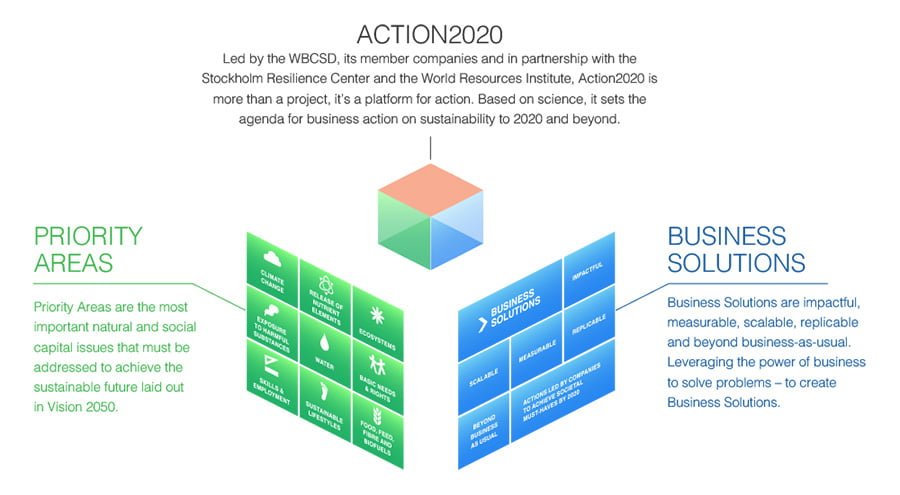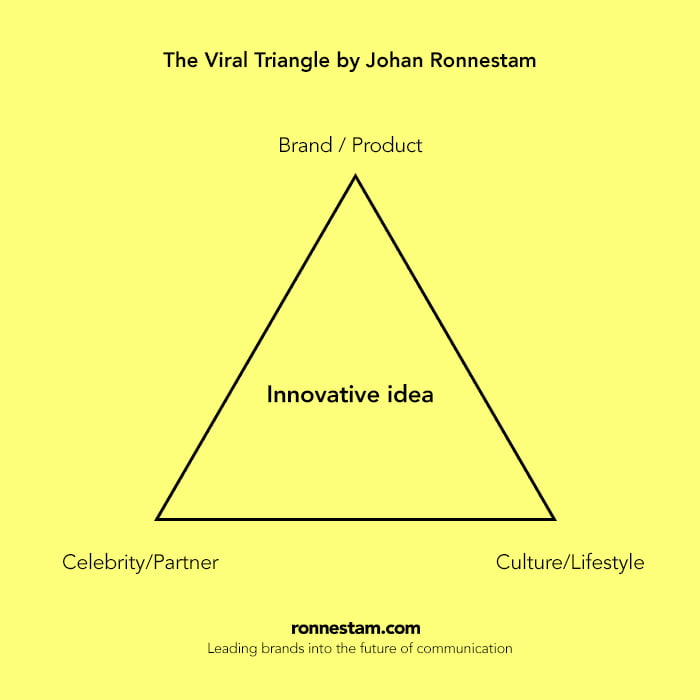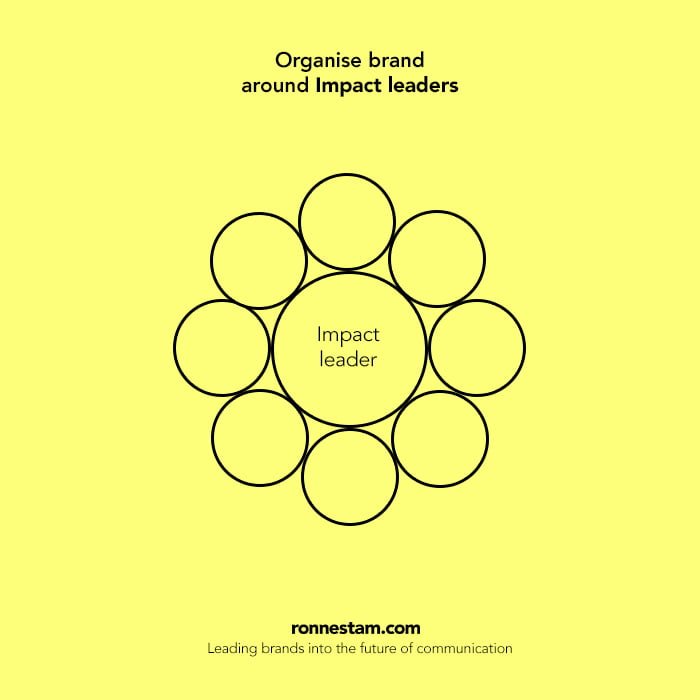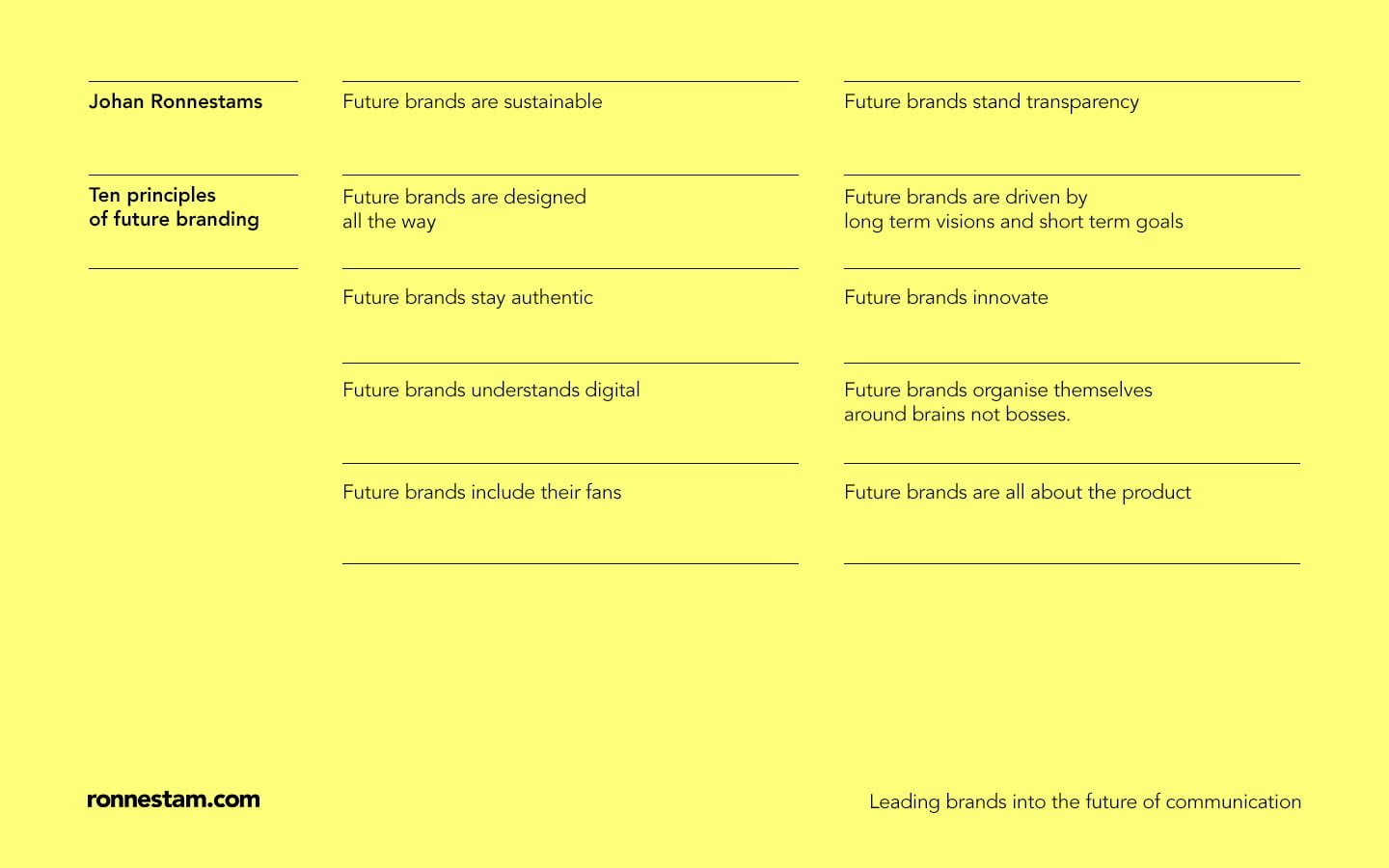The other day I read a great post by Joshua Porter on the Principles of Product Design. It’s an area that I’m very fond of and the post by Joshua was spot on. Then as I’m a fan of Dieter Rams and his Ten Principles for Good Design I decided to write my own ten principles on future branding.
But first ›› The ten principles on future branding can be downloaded here as a high res picture for printing.
Here are Johan Ronnestams Ten Principles of Future Branding:
![]()
1. Future brands are sustainable
During 2014 the World Business Council for Sustainable Development created a roadmap for how business can positively influence environmental and social trends while strengthening their own resilience to issues like climate change, demographic dynamics and skills shortages. It is called Action2020 and it sets an agenda for brands on how to take action on sustainable development to 2020 and beyond.

If you’re the owner or manager of a brand, sustainability is not something you should consider. It’s something you should act on now. Our future generations will thank you for it and as a return they will buy your products. So far most companies and brands have yet to start their sustainability action plans. But moving into the future it should be a natural part of every part of your business – from product development to final product, packaging and advertising. Be responsible!
2. Future brands are designed all the way
Dieter Rams inspired this post with his Ten Principles of Good design. His words are more important than ever!

Dieter Rams. The Godfather of good design
Dieter Rams ten principles of good design:
- Is innovative – The possibilities for progression are not, by any means, exhausted. Technological development is always offering new opportunities for original designs. But imaginative design always develops in tandem with improving technology, and can never be an end in itself.
- Makes a product useful – A product is bought to be used. It has to satisfy not only functional, but also psychological and aesthetic criteria. Good design emphasizes the usefulness of a product whilst disregarding anything that could detract from it.
- Is aesthetic – The aesthetic quality of a product is integral to its usefulness because products are used every day and have an effect on people and their well-being. Only well-executed objects can be beautiful.
- Makes a product understandable – It clarifies the product’s structure. Better still, it can make the product clearly express its function by making use of the user’s intuition. At best, it is self-explanatory.
- Is unobtrusive – Products fulfilling a purpose are like tools. They are neither decorative objects nor works of art. Their design should therefore be both neutral and restrained, to leave room for the user’s self-expression.
- Is honest – It does not make a product appear more innovative, powerful or valuable than it really is. It does not attempt to manipulate the consumer with promises that cannot be kept.
- Is long-lasting – It avoids being fashionable and therefore never appears antiquated. Unlike fashionable design, it lasts many years – even in today’s throwaway society.
- Is thorough down to the last detail – Nothing must be arbitrary or left to chance. Care and accuracy in the design process show respect towards the consumer.
- Is environmentally friendly – Design makes an important contribution to the preservation of the environment. It conserves resources and minimizes physical and visual pollution throughout the lifecycle of the product.
- Is as little design as possible – Less, but better – because it concentrates on the essential aspects, and the products are not burdened with non-essentials. Back to purity, back to simplicity.
The importance of design for brands that wants to stay in the game tomorrow cannot be understated. Design is something the consumer expect from brands that matter. Being design driven means that your brand cares for design in every step of the consumer journey. Your marketing, websites, DMs, email campaigns, coupons, events, packaging, store design, POS material, staff appearance, how your customer service acts, newsletters, loyalty programs and of course ultimately the product. I’ve written before about how Apple really shows how to act.
Design has to be in the core of your brand and the people that work with it. Both on the inside of the company and on the outside. Anyone that comes in contact with your brand should have both an emotional and functional relation to your brand. Design is equally important in both those relations.
3. Future brands stay authentic
A quick Google tells you that Authentic means- not false or copied; genuine; real. Being authentic is what future branding is all about. No one wants a product that isn’t genuine and real. Not you, not me, not the environment, not the world. Heck, not even the universe wants products that aren’t authentic. Authentic products ans services solve real problems, they are made to last with the least possible impact on the environment. Authentic products is something the buyer is proud about meaning he or she can tell her friends about it.
Patagonia is the perfect exempel of a future brand that create authentic and sustainable products that matter for the consumer. Have a look at this video showing their latest wetsuit innovation – Patagonia Yulex. A great innovation that Patagonia actually are giving away in order to achieve their vision. Patagonia Yulex is made from natural guayule biorubber refined in a water-based separation process in order to reduce Patagonias dependence on traditional neoprene. A better path forward for the surf industry.
Authenticity is about being able to motivate every single function, every material and every part of the design. Being authentic is about creating a brand that stands the tests of time. An authentic brand is a true brand that doesn’t have to fear anything. An authentic brand equals a passionate brand. Last but not least. An authentic brand handles transparency – one of the great future challenges for companies and brands.
4. Future brands understand digital
Internet is tearing down the walls between governments, brands and people. Beyond those walls a new communication landscape emerges where the consumers rule and have got the power carry brands to the top or bury them alive. This new world is defined by technology and belongs to the people. In this world you’ve gotta listen, learn and move your brand activities from short lived campaigns to an ongoing ever-changing brand conversation where quality is key and product is king! I’ve written so much about this before – but if you want a compilation I think you should read up on my Top 10 Blog Posts on Future Branding and Communication From Ronnestam.com and then follow related links from there.
Strive to make everything about your brand viral
It’s getting more and more complex to reach the consumer. Printed medias, a sure way to reach our consumer only 5-10 years back are becoming obsolete. TV as we know it is loosing its unique power to help brands sending messages to the masses. We were all hoping for social media, but that’s not a pay for eyeballs game – it’s a game of relevance, personal preferences, banner blindness and above all having a product, idea or communication that is built to be viral.

I’ve written before about the viral triangle. That model still stands. In order for your brand to succeed in the future you’ve gotta implement viral components in every part of your brand. Make your products, services, user interfaces, customer service, communication and more, something to love and talk about – cause people like to talk about things they love.
5. Future brands include their fans
The customer is empowered. Transparency allows for anyone to make their voice heard. Your brand is entering a future where it will become harder and harder to acquire new customers while it’s easier than ever to loose your existing ones. Information is at our finger tips and a friend in a social network, a blogpost review or a comparison engine is only a keystroke away. Future brands must think customer in all steps of the value chain. Interaction with they customers is key in product and service development, not in the sense of asking people what they want, but observing behaviours and finding patterns that steers you and your brand in the right direction. Remember what Steve Jobs used to say “If you want to surprise people, don’t ask people what they want”. Once your product is developed and the time has come for marketing and sales – your customers are just as important as they are the advertising space of tomorrow. How can you involve your customer in the process of marketing your product? I’ve mentioned viral marketing above. But there are more ways. Can you ask your customers to participate in your marketing?
That’s me helping GoPro to become a loved brand. How do you involve your customers?
Compare Redbull and GoPro. Redbull works with broadcasting, they pay shitloads of money in order to make you watch their content. GoPro on the other side, they sell products and then ask you to participate by uploading content to their online platforms. Their tagline “Be a hero” clearly communicates that their product is about you. What kind of communities can you build around your product, how can you involve people in your marketing, how do you inspire people to participate and where can people feel involved in your brand?
Finally, listening to what customer has to say about our brands is essential. People do all kinds of things with your brand today. We blog, we Facebook, we comment, review, love and hate your products online. Social media allows us to talk to our customers – for me the product and service should do the talking. Listening however is something you and me should do. What do people say about our brands, this is where the gold can be found. Using social media to track conversations what people say about your brand and product is key. This is the source that should guide your brand into the future, both in terms of potentially new products and the development of existing ones, but also guiding your communication activities, your tone of voice and the way your brand can be innovated. If you’re a small company or even an individual like me, why not use my 21 steps to monitor your brand and keep track of conversations online. If you’re a larger brand or organisation then use something like Radian 6, Meltwater Buzz, Sysomos, Adobe Social, Netbase or maybe a new swedish kid on the block like Notified or Lissly.
6. Future brands stand transparency
Prepare your brand for transparency. Digitalisation of information means all information will be accessible anytime and everywhere. This means I’ll get all the information I want about your brand, your products and services whenever I want. Comparison engines will kill price wars – there will be only one price and I wont pay more than I need. The race will be won on other frontiers like the ones this blog post is all about. Innovation, design, virality, user involvement, customer service and more. Transparency means each and everyone in your organisation must have this understanding.
A good business idea ten years ago was to invest heavily in technology and then ask people for their money if they wanted access. Today competition is global and there’s always someone willing to disrupt your brand, your product and your price model. We’ve seen it happen over and over again the last couple of years. A traditional brand tries to keep prices high and then someone else disrupts. The recipe is simple – you choose a market, you create a product ten times BETTER than the competition and you price your product ten times LOWER than the existing product on the market. This way you’ll get massive amount of new customers that actually makes your profit high, you’ll get viral effects, social media coverage and most important – access to consumer data that makes it easier for you to stay ahead of the competition.
There is another strategy – that is to make sure your product is extremely unique. This can be done by innovation and investment in extreme technology and above all – by being extremely creative. This is the strategy Apple have had the last decade. However, staying unique is difficult, everyone want’s your position and while you’re fighting to stay innovative other people recruit your staff, steal your customers and think different. Remember – everyone becomes old at last if they don’t disrupt themselves.
7. Future brands are driven by long term visions and short term goals
The first rule of branding and especially future branding is to do something that matters. Why do you exist. What’s the purpose of your brand. What different are you making. The future consumer looks for real meaning. In order for me to carry your brand you have to do something that I’m proud of. A great advertising campaign doesn’t cut it anymore. A great company with a mission to do good however means something. By using your products and service the consumer can take a small part in making that mission happen. Consumers that buy products for a higher reason are more eager to tell other people about brands they love.
“If everything you do needs to work on a three-year time horizon, then you’re competing against a lot of people, But if you’re willing to invest on a seven-year time horizon, you’re now competing against a fraction of those people, because very few companies are willing to do that.” – Jeff Bezos to Wired Magazine in 2011
Yet you have to consider the fact that the world is spinning faster than ever. Mobile for example was not important 2-3 years ago. Today it’s key for every brand to understand what mobile does to their business. This means you have to plan for a long term vision but make sure you can change your tactical plan in a short term perspective.
We will continue to measure our programs and the effectiveness of our investments analytically, to jettison those that do not provide acceptable returns, and to step up our investment in those that work best. We will continue to learn from both our successes and our failures. – Jeff Bezos in his letter to Amazon employees in 1997
In other words. It’s extremely important to know where you’re heading from a long term perspective while organising yourselves and do things in a short term perspective and then iterate your way forward – always with that vision of how your company can make a difference in the future. This insight allows you to fail today and learn from it in order to succeed tomorrow.
8. Future brands innovate

Great Brands constantly innovate. In one way I love this one, in another I hate it. People crave innovation and it brings you and me great products. However it’s not very good for the environment so I trust you innovate intelligently. In this world of information over flow we constantly need to be reminded of brands and their products. And as advertising old products doesn’t do it there’s only one solution – Innovation. Remember though ›› Innovation is profitable implementation of new ideas. Have a read up on my process for innovation – prototyping.
9. Future brands organise themselves around brains not bosses
Internet empowers people. This is the one thing you need to understand about the world of technology. It means that everyone, you and me, got the ability to create whatever we want with a computer, an internet connection and an understanding of digital globalisation. I’m not talking only about digital services. The fact that you and me can sit at home, create drawings, 3D files, code things, even print prototypes and then connect and communicate in seconds with producers all over the world means that the power no longer sits with the establishment, the managers and the people with money. It sits with creative people who understands technology and business. Traditional companies are organised around CEO’s, managers and middle managers who’s role is to steer other people. This model does not work anymore.

In order for your company and brand to succeed you’ve gotta organise your company around the brains, the people who have an impact on your long terms results – Google calls these people smart creatives. Find people who want to make a difference, empower them with any resources they need and build a team around them. Jeff Bezos at Amazon calls these teams Pizza Teams – with that he means that no team should be bigger than that they can share a pizza in a meeting among themselves. Your role as a CEO or a manager is now to build a support organisation around these ‘pizza teams, these hubs of innovation – I call these teams Impact Teams.
Think of yourselves as a coach for a football team. No football manager in the world would build a football team organised around the coach – for a football manager it’s obvious that the team should be organised around the players with the most impact over teammates and the ability to win matches.
10. Future brands are all about the product
The one principle that sums up the ‘Ten principles of future branding by Johan Ronnestam’ is this one – Future brands are all about the product. If you understand future branding you also understand that the only way to build a strong brand in the future is to focus on your products.

If your product is world class in terms of authenticity, value, functionality, design, sustainability, innovation, quality, technology you can sit back and watch the consumers doing the marketing for you. I call this the trojan horse of digital. Future brands and products are authentic, designed and innovative. Make sure you brand and products contain all three of this and you’re well on your way to build a brand that stands the test of time!
